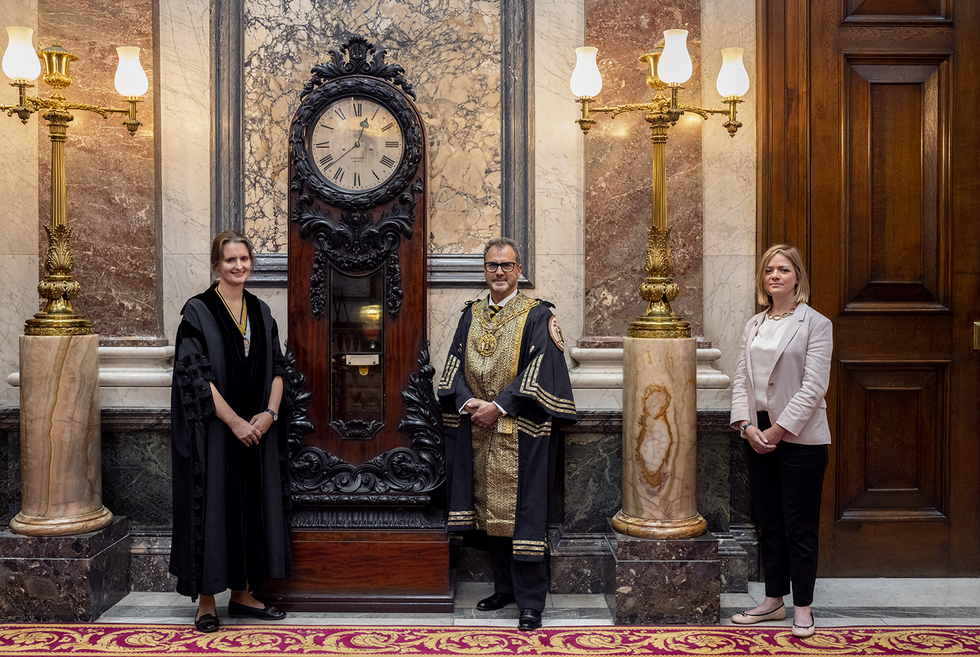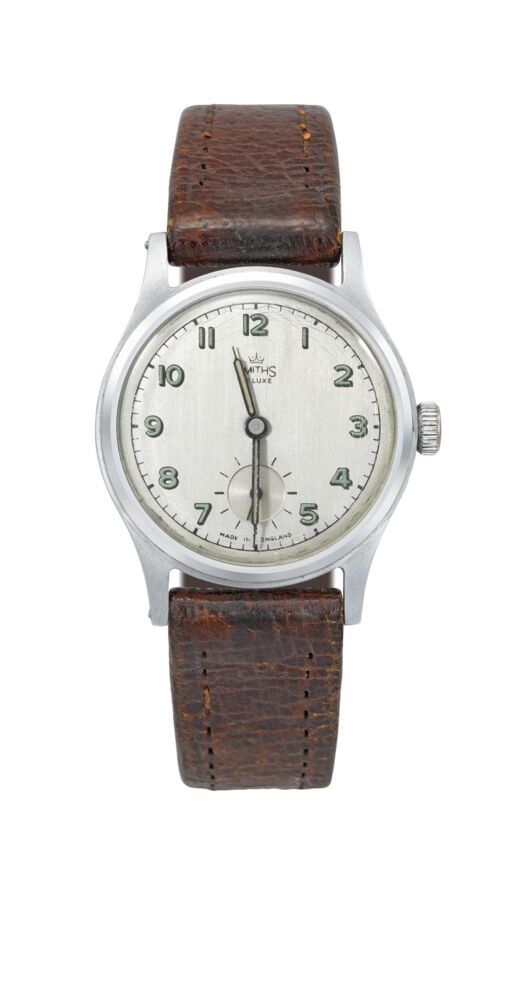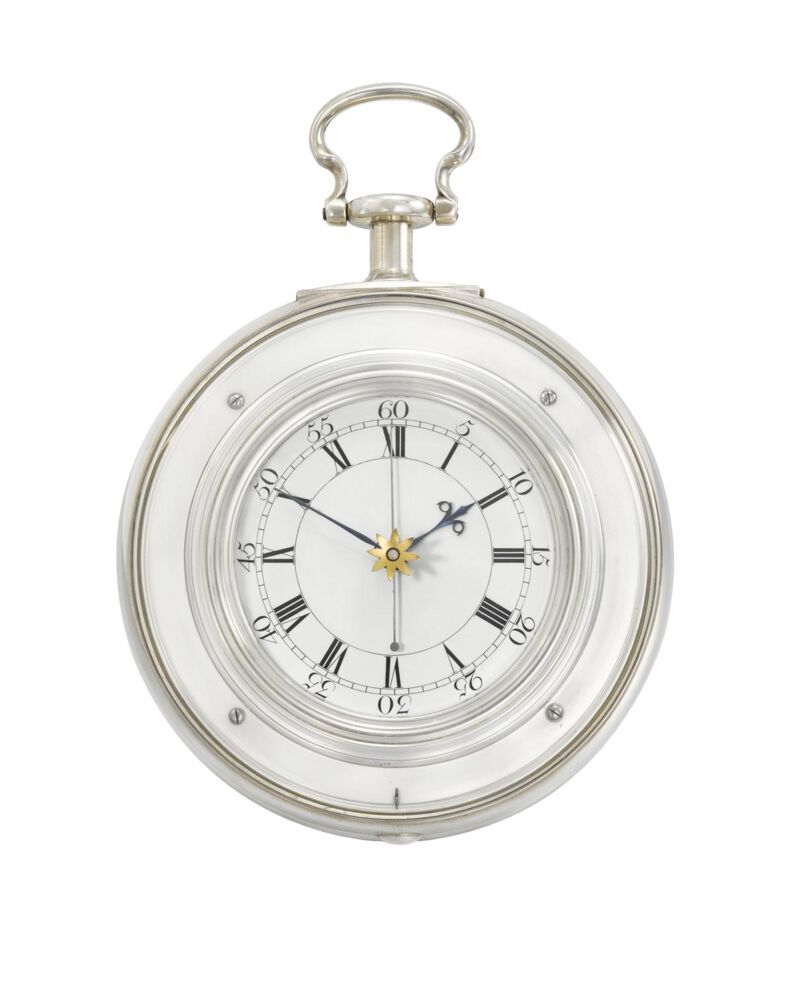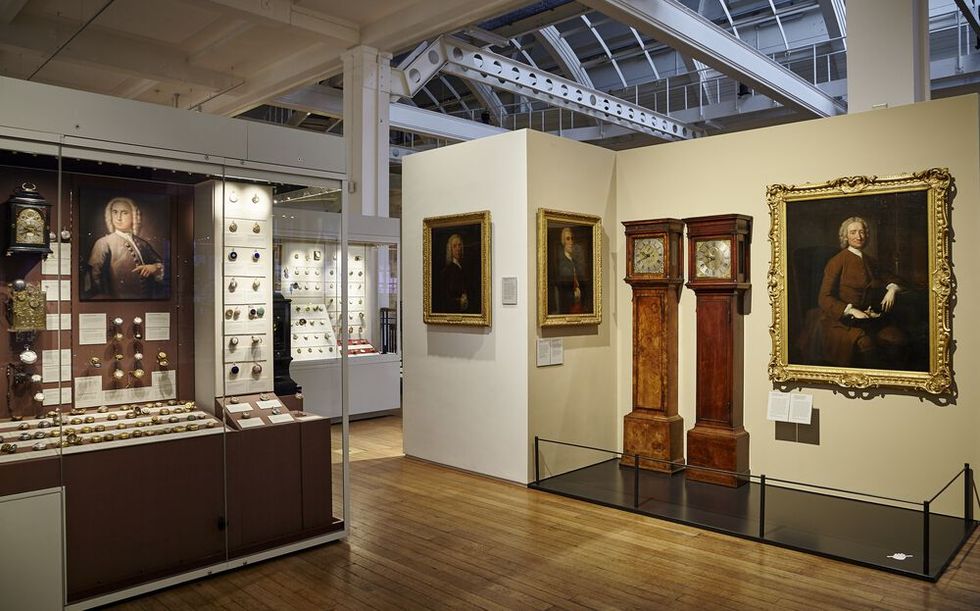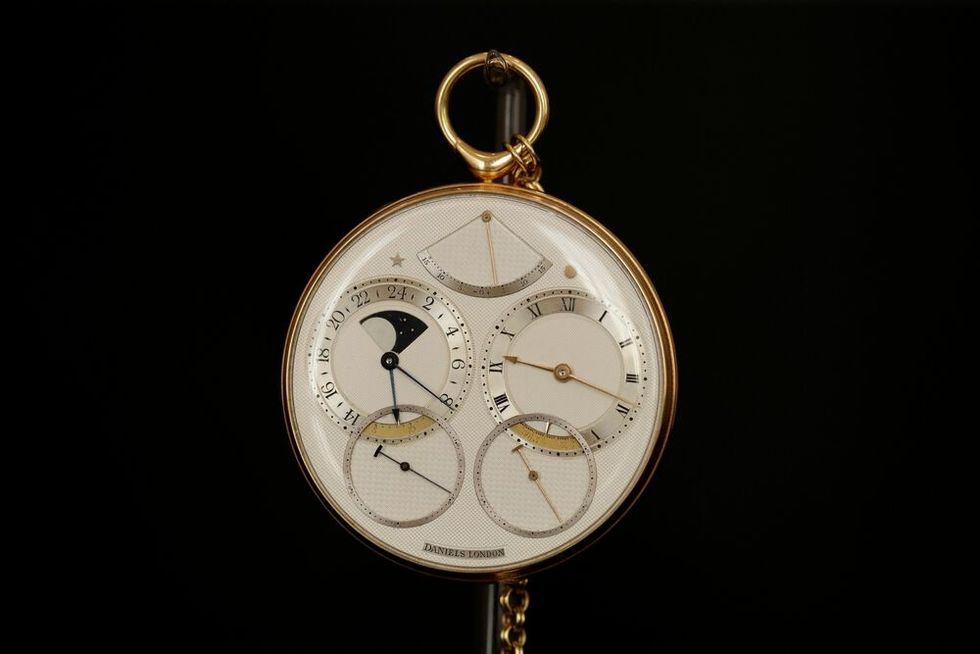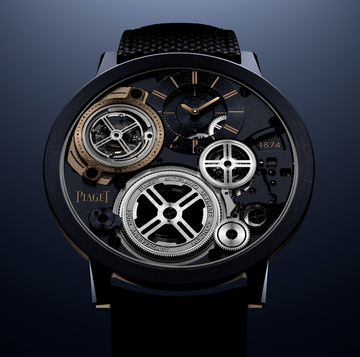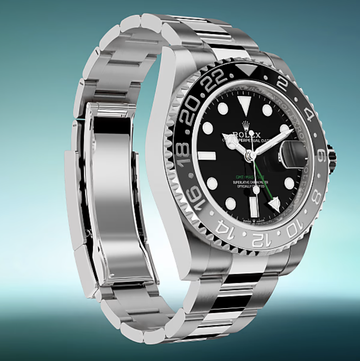James Nye has the assistant chaplain at school to thank for his career. For any boys not interested in rugby at Ardingly College in West Sussex in the 1970s, Reverend Waters offered lessons in basic clock repair. In a workshop packed with benches, Schaublin lathes and cleaning machines, Nye learned about simple English dial clocks, longcase clocks and French drum movements. He was smitten.
Aged 13, he had taken charge of the school’s Gents-based clock system, where a central clock sent out an electrical pulse at 30-second internals to every clock in every classroom, and to the other buildings within the Gothic Victorian school-grounds. “I adored it,” he remembers. “I’ve loved distributed timekeeping systems ever since.”
Today, Nye is a historian who writes, lectures, publishes books and owns his own wide-ranging collection of electric time artefacts. He chairs the Antiquarian Horological Society’s council, is a member of the British Horological Institute and founded the Clockworks Museum in London. Most stately of all, having previously chaired its collections committee, this year he was elected to be Master of the Worshipful Company of Clockmakers — an unimprovable job title if ever there was one.
The Worshipful Company of Clockmakers is the oldest surviving horological organisation in the world. It was founded under royal charter by the first King Charles, in 1631. In the Company’s early days, membership was required in order to be in the business of clock or watchmaking in London. Nowadays, it is a charitable institution.
It also owns and maintains the world’s oldest clock and watch collection, known as the Clockmakers’ Museum. The collection includes more than 600 watches, 90 clocks, 30 marine chronometers and a number of sundials. Highlights include H5, the watch developed by John Harrison to solve the long-held problem of working out longitude at sea, a “Memento mori” watch in an engraved silver skull, once believed to have belonged to Mary, Queen of Scots at the time of her execution, and the Smiths De Luxe wristwatch worn by Sir Edmund Hillary as he reached the summit of Everest in 1953 and donated to the Clockmakers the same year.
For 141 years, this collection was located within the Guildhall complex in the City of London. In 2015, it found a permanent new home in the Science Museum in South Kensington, where precise numbers for the increase in footfall are hard to calculate — save to say there has been a significant uptick. Helped, no doubt, by the Science Museum also being home to such crowdpleasers as the oldest surviving steam locomotive, the first jet engine and the Apollo 10 Command Module.
The history of clock and watchmaking in Britain follows a familiar graph. The arrival of European immigrants into London in the 17th century; the development of a homegrown industry that comes to dominate the globe in the 18th century, before complacency sets in during the 19th century as other nations build up their own versions. A complicated picture involving world wars and midcentury governments disinclined to interfere in the economy follows in the 20th century. By the 1970s it has all gone horribly pear-shaped, and the British watchmaking industry, once the envy of the world, is over.
That would make the Clockmakers’ Museum an institution of historical interest only. But Nye, whom I met at the Science Museum one morning recently, is keen to point out there is a coda to this story. It has left us with a few self-taught mavericks who have had no option but to take things into their own hands, and produce incredible handcrafted, hand finished watches as a result: Rebecca Struthers, the award-winning designer, watchmaker and historian, half of the Birmingham based husband-and-wife marque Struthers Watchmakers, and Roger W Smith — one of the greatest independent watchmakers of the modern era, headquartered on the Isle of Man, with an output of 10 watches a year and a waiting list of five — to name just two.
“The Museum is a reflection of all that history, but it’s also an expression of a hope that there is a future for the trade, which is why we’re so involved in the idea of education in horology,” says Nye. “Do you want to be a maker? Do you want to work as a conservator? Do you want to work for a dealer? Because, actually, there are lots and lots of jobs for watch- and clockmakers.”
Nye had not long returned from a prize-giving ceremony for Birmingham City University’s BA in horology, where the number of students this year is higher than in any previous year. “We hope to support those people, through our nascent apprentice scheme or by providing the funding that’s needed for people to get through college,” he says. “We also want to build bridges to the scientists, like NPL [the National Physical Laboratory in the UK’s National Metrology Institute], the people who deliver time to the City. Those transactions have to be timestamped to a millionth of a second. We want the scientists developing modern timekeeping technology to see us as their ancestors and the guardians of where they came from. They should be proud of us and we should be proud of them. That’s the task of the Clockmakers’ Company, to build a bridge into the future of timekeeping.”
The Clockmakers’ Museum is unique in its age and scope, and because it tells the story of clock- and watchmaking in London.
It was in London that scientists and craftsmen made and exploited the most significant inventions leading to accurate timekeeping in the 18th century. Prior to that, Henry VIII and his successors encouraged mathematicians and foreign makers to settle in London and bring their skills with them. As a result, a group of domestic clock and watchmakers working in the Renaissance style flourished in the City, especially in and around Blackfriars. Since craftsman could not legally work in the City without joining a guild or “livery company”, clock and watchmakers sought the freedom of any guild that would have them. Many joined the Worshipful Company of Blacksmiths. Like other liveries, the Worshipful Company of Clockmakers was established to regulate its industry, to protect the public from fraud and to keep rival foreigners at bay.
An early success came when Ahasuerus Fromanteel pioneered pendulum clocks in the mid-1600s, based on Galileo’s observations of the natural timekeeping properties of the pendulum, an endeavour that earned him the patronage of the Lord Protector, Oliver Cromwell.
“We suddenly had a precision instrument, this kind of kit,” says Nye, standing next to an oak-enclosed longcase clock commissioned by Thomas, 1st Earl Coningsby, for a visit from King William III, and later owned by Sir Richard Arkwright, a celebrated entrepreneur in the industrial revolution. “There’s a pendulum inside here that’s a meter long and takes one second to swing from side to side, because the centre of gravity to the suspension is very close to a meter.”
Within decades, Thomas Tompion (“the father of English clockmaking”) had teamed up with Robert Hooke (“England’s Leonardo”) — physicist, scientist and the inventor of the balance spring in watches. The pair took their ideas from the coffee houses of Bishopsgate to the great and good of the period: Christopher Wren, Jonas Moore and Charles II.
Horology and science combined and “the golden Age of English clockmaking” (roughly 1666-1700) was upon us, when London produced some of the finest clocks and watches in the world. John Harrison took up the British government’s challenge to find a solution to calculate longitude in 1714, winning £20,000 prize money (about £2.7 million today) with his fourth and fifth marine timekeepers — the latter of which is arguably the star of the Clockmakers’ Museum collection.
“Horology became a major trade,” Nye says. “If you were at the top, you’d have your premises on Fleet Street, which was the Bond Street of its day. You can imagine the road that leads down to Westminster, to the City, to St Paul’s. Fleet Street was where the silversmiths and goldsmiths had their showy, expensive wares and clockmakers had their shops. But while they were selling highly expensive objects to very rich people, they were also creating something required by the scientists of the day — Cooke, Newton and others needed their kit.”
Britain produced 200,000 watches a year by 1800, fuelled by mechanical improvements such as cylinder and lever escapements in watches and the deadbeat escapement in clocks. Mechanics formed the basis for the industrial revolution, and London makers had a market across Europe, even in France, where exquisite horology was becoming a source of national pride, and extending to Russia, the Middle East and China. Top-end 21st-century watch brands like to boast of “vertical integration” — where every component is made under the same roof — but the opposite was true back then. Specialist craftspeople worked as dial makers, enamellers, glass makers, wheel cutters and so on, with at least 30 different skills needed to complete each piece.
Triumph and disaster followed in the 19th century. The ability to navigate accurately contributed significantly to Britain’s ascendancy at sea, allowing the country to explore and to colonise. The refinement of marine chronometry was greatly encouraged by the Clockmakers’ Company, who regarded those employed in their manufacture as “the elite of the workmen, selected out of the great mass”.
The Clockmakers’ Company also fought hard to achieve higher import barriers, to prevent the entry of smuggled goods and to boycott continental manufacturers from setting up a factory in the capital. Despite this, the belief of watch- and clockmakers that their customers would never fall for cheaper, machine made timepieces from America, Germany and elsewhere proved misplaced.
The Clockmakers’ Company offered prizes in an attempt to encourage quality, while the first world war prompted an increased demand for homegrown timekeepers. But the old-fashioned methods proved unsustainable, and repeated homegrown attempts to mass-produce the newly popular wristwatch failed.
As per James Nye’s coda to the story, recent years have offered a few brighter spots for British horology. The Worshipful Company of Clockmakers has sought to assist, encourage and protect its trade for nearly 400 years, and it isn’t about to give up now.
The knock-on effect of the shutdown of specialist part-makers has meant that those entering horology have had to master multiple skills. This has led to some pioneering independent British watch and clockmakers, including Martin Burgess, Derek Pratt and Anthony Randall.
But the giant among them is George Daniels. Brought up in poverty in Sunderland in the 1930s, Dr Daniels, as he is known in the watch world, was forced to become entirely self-sufficient. Aged five, he prised off the back of his family’s alarm clock and — so the story goes — there he saw his destiny in microcosm: a machine moving inexorably onward, without outside assistance. After being demobbed from the army, he studied at night school, working “16 hours a day... seven days a week” in watch repairing.
“I was the only maker of handmade individual watches working long hours to establish a London workshop and gain the attention of those collectors who could understand what I considered to be the importance of such a venture,” Daniels writes in his 2000 autobiography All In Good Time.
Appalled by the flood of imported quartz watches in the 1960s, he resolved to fight back. He embarked on a one man mission to show that a market still existed for quality timepieces with components made entirely by hand and finished in the traditional English way, with features such as frosted movement plates, engine-turned dials and jewels set in gold chatons.
Having taught himself to make each and every part, Daniels produced a series of superb one-off mechanical watches. In 2019, his Space Traveller I sold at Sotheby’s for £3.2 million, a record for an English watch at auction. In 1980, Daniels patented the coaxial escapement, one of the few advances in watch movements since the 18th century. Patek Phillipe rejected his invention, but it was taken up by Omega, which has used it in the majority of its watches since 1999.
Daniels, who has been called “the greatest watchmaker of the 20th century”, died in 2011. But his fierce dedication and meticulous practises live on in the hands of his only apprentice, the aforementioned Roger W Smith. A tourbillon watch called The Blue, designed by Dr Daniels and assembled by Mr Smith between 2001 and 2005, recently sold for £1 million.
Anna Rolls began working as the curator of the Worshipful Company of Clockmakers in 2018. Before that, she was a conservator of metalwork and scientific instruments at the Royal Museums Greenwich.
“I started out on a very different career, making big metal sculptures,” she tells me in the Company of Clockmakers’ third-floor office under a portico on London Wall, in the heart of the City. “Then I decided I wanted to do something a bit more engaged with the past, that would help a wider number of people. So I went back to learn conservation and restoration of metalwork.”
Her role now, looking after a collection of hundreds of watches, clocks, chronometers, written records and other bits of horological ephemera, is, she says, perfect. “The realisation [I had] was that there was this combination of science and maths, art and history — all the areas I was keen on. But when you’re at school it’s quite hard to marry those up.”
Sat across a wooden table from her is Camilla Szymanowska, clerk to the Worshipful Company of Clockmakers. Szymanowska comes from the world of rare books, a job she got into “because I decided I didn’t want to be a corporate lawyer”. (She passed her job interview, “in a Mayfair townhouse, with a strange, bearded man”, who handed her a book in Greek and asked her to identify it. She was able to, as she had been a student of classics.)
Szymanowska jumped from the books trade into the Clockmakers’ Company in 2019, and sees parallels between the two worlds. “There’s a lot of crossover between book people and clock people,” she says. “They’re all kind of... unusual. Book people get obsessed with little gold decorations on the covers of books, and watch people get obsessed with little gold decorations on the front of watches.” They both have, I suggest, quite unusual jobs.
Szymanowska puts it another way. “One of the joys of the livery is that it is so rooted in history,” she says. “There are 110 clerks in the country, and that’s it.” She points to a framed list of 21 names handwritten on vellum above her desk. “There’s a list of all the people who have done my job since 1631. The masters change every year, but the clerks
sit around for a while. I’m the first woman.”
While it can sound fusty and rooted in tradition, the Worshipful Company of Clockmakers is one of the more unusual of the capital’s trade associations and guilds, in that people still care about the thing it was created to protect. Spare a thought for their colleagues over at the Worshipful Company of Paint-Stainers, or the Worshipful Company of Gold and Silver Wyre Drawers. And at least neither have suffered the ignominy of having to rebrand, like the Worshipful Company of Horners. (Following the decline of the trade of horn working, since 1943 it has been concerned primarily with supporting the plastics industry. Another rebrand must surely be on the horizon.)
“Even now, many hundreds of years after its formation, everyone is still interested in horology,” Szymanowska says. “Our Company motto is ‘Time is the ruler of [all] things’. Clockmaking and time and everything we do is absolutely intrinsic to what everybody else does.”
Plus, it’s not as if they haven’t had to roll with the times themselves. “We used to have the right to go on boats in the Thames, and if there were foreign-made things, you could smash them up,” Szymanowska says. “People fiercely protected their trades.”
On top of the day-to-day running of the Company, dealing with new acquisitions and loans, organising the conservation of the collection and operating as a charity that can help with the restoration of public clocks (church ones; Big Ben), their work involves keeping British watchmaking ticking into the 21st century and beyond.
James Nye and Anna Rolls both lecture around the world, and the Company supports students and apprenticeships wherever it can. The Clockmakers’ Museum’s transfer to the Science Museum has been a big plus. “We’re getting an audience we never had before,” Rolls says. “Children, young people, students. Even if they’re just passing through, you have that moment of ‘What’s this?’ You couldn’t have asked for a better place. There’s just something about a mechanical watch or a mechanical clock over a smartwatch or a quartz watch. There’s the feeling you could take it apart, you could repair it. You could look after it yourself.
“Although we wouldn’t necessarily recommend you did,” she adds.
Back at the Science Museum, I asked James Nye if he’d mind removing
his own watch. I’d been trying to place it, but without luck. It became apparent why. “It’s the one George Daniels really wanted to make, the double-impulse escapement. Omega makes a huge selling point [of his invention] but it’s rather... Daniels-lite. As you can see, it’s a chronometer with twin escape wheels but one balance.”
It was a magnificent thing. A gold dress watch with a bright white zirconium dioxide dial, Roman numerals and skinny hands of unusual, equal length. The dial bore the legend “Chas Frodsham London”.
Charles Frodsham & Co Ltd had set up in the City in 1834, and the name survives as the longest continuously trading maker of chronometers in the world. In January 2018 it successfully bought Daniels’ design to life. The Double Impulse Chronometer wristwatch has been called “the most significant British watch of modern times”.
It took 16 years to develop. “This is the first one,” said Nye. It had, he said, been worth the wait.
